The Angelbird Wings PX1 M.2 Adapter Review: Do M.2 SSDs Need Heatsinks?
by Billy Tallis on December 21, 2015 8:00 AM ESTMixed Random Access
Instead of testing a range of queue depths, our mixed workload tests vary the proportion of reads and writes while using a constant queue depth. The test begins with pure reads, then incrementally shifts toward pure writes with three minutes for each subtest. As more writes come in to the mix, the odds increase that a read request will be held up by one of the flash chips being busy with a longer-duration write. Likewise, having lots of reads in the mix can limit the drive's ability to combine writes into larger batches. Thus, the worst performance on these tests usually occurs somewhere around the middle. To approximate client workloads, the mixed random access test uses a queue depth of three and like the random write test it is restricted to a 16GB portion of the drive.
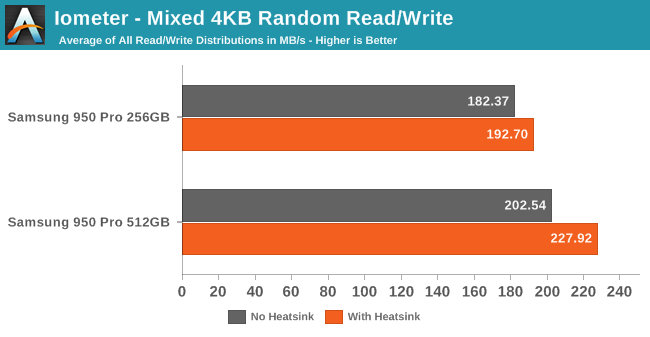
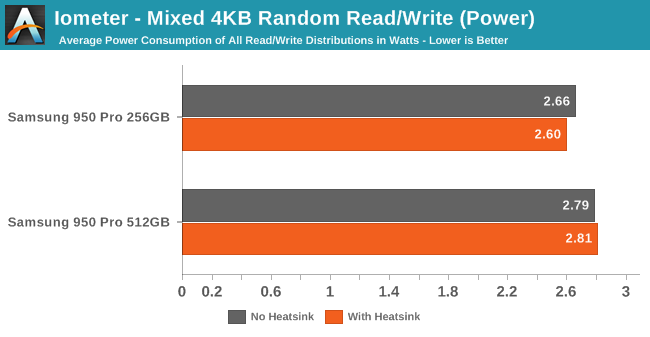
The mixed workloads were the only tests where the two capacities showed significant performance differences even without the heatsink, indicating that thermal throttling was much less of an issue for the 950 Pro here. The heatsink still helps, but only slightly. Given how random reads were essentially unaffected by the heatsink, it's a bit of a surprise that the writes improved by enough to bring the average up by 12.5% for the 512GB drive.
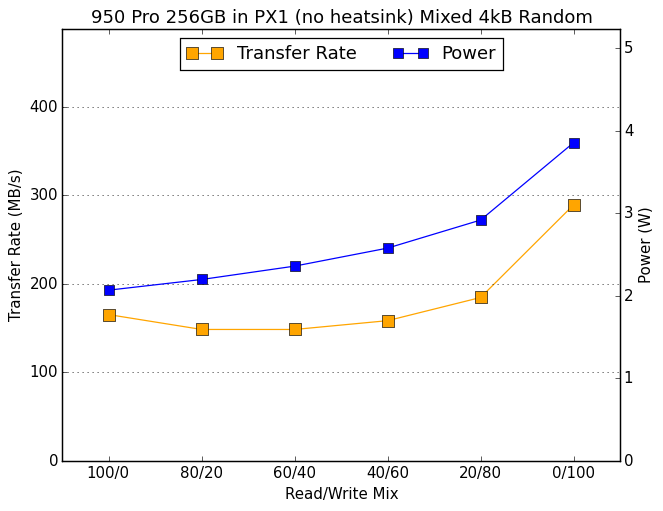 |
|||||||||
| 256GB no heatsink | 512GB no heatsink | ||||||||
| 256GB with heatsink | 512GB with heatsink | ||||||||
Almost all of the performance improvement with the heatsink comes at the very end of the test as it shifts to pure writes. Performance earlier in the test is virtually unaffected by the heatsink, but power efficiency does see the slight improvement from lower operating temperature.
Mixed Sequential Access
As compared with the mixed random test described above, the mixed sequential test differs by using a queue depth of one and by requesting larger chunks of data. This test operates across the whole drive, which is pre-filled with data.
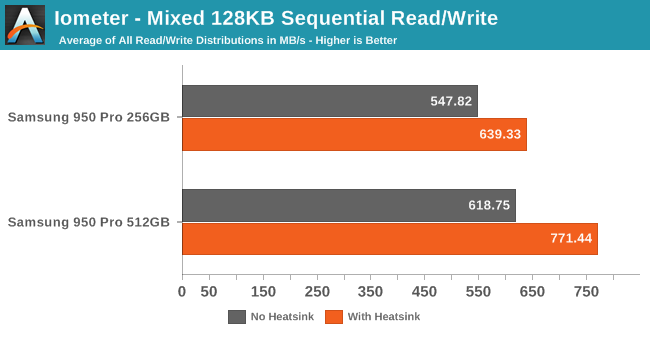
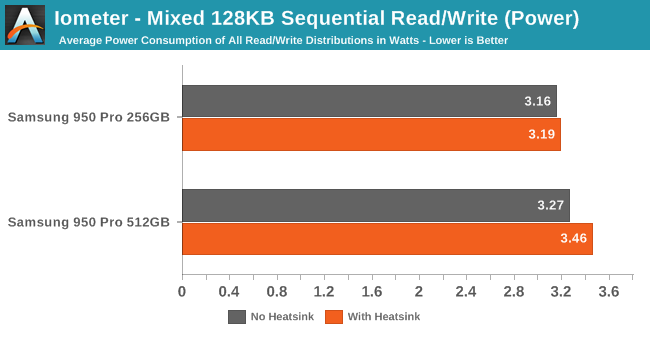
Both of the previous sequential performance tests showed huge improvements even at low queue depths, so it's no surprise to see a significant improvement in a mix of the two.
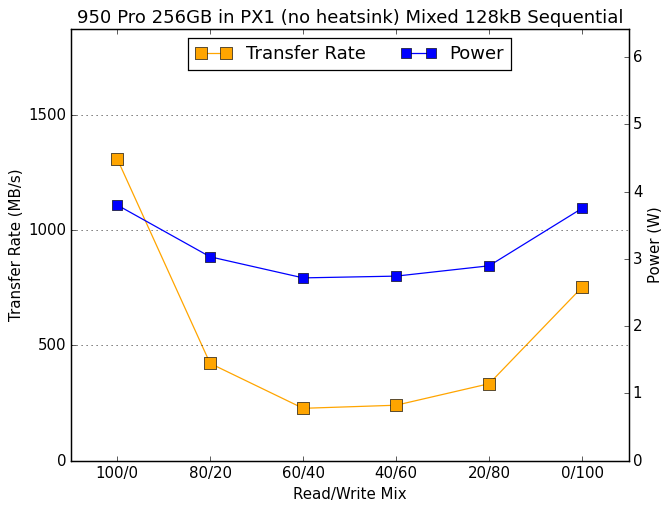 |
|||||||||
| 256GB no heatsink | 512GB no heatsink | ||||||||
| 256GB with heatsink | 512GB with heatsink | ||||||||
A closer look reveals that the overall performance improvements are once again attributable to the non-mixed segments of the test. Unlike the mixed random test, read speeds are part of the improvement here. But on the sub-tests with a balanced mix of reads and writes, the 950 Pro wasn't throttling even without the heatsink.










69 Comments
View All Comments
Ryan Smith - Monday, December 21, 2015 - link
That is actually correct. The drives are more consistent when they thermally throttle because the controller has plenty of time to catch up. Whereas with a heatsink they're running at full tilt, and sometimes the controller has trouble keeping things consistent.tipoo - Monday, December 21, 2015 - link
Huh, interesting.tipoo - Monday, December 21, 2015 - link
So why is the scenario the exact flip on the 256GB drive? Did it just finish the test sooner?Billy Tallis - Monday, December 21, 2015 - link
During thermal throttling, the 256GB was occasionally stuttering and dropping from 6k IOPS to 2k IOPS. That tanked the consistency score. The 512GB's performance regulation when thermally throttled was basically perfect—during steady state it never deviated from ~6k IOPS.Magichands8 - Monday, December 21, 2015 - link
I really don't get why so many people seem to love M.2 so much. Sure it's convenient for laptops but for just about anything else it's a severely limited form factor restricting capacity and adding heat issues while eating up precious expansion slot space on the motherboard. What I'd really like to see are U.2 SSDs with 10 times the capacity.nwarawa - Monday, December 21, 2015 - link
The performance is obvious plateauing with that heatsink, so it begs the question: what is good enough? I assume it's just the controller that needs to be cooled. Would one of those tiny chipset heatsinks with some thermal tape still see most, if not all, the benefit of this Angelbird heatsink?Billy Tallis - Monday, December 21, 2015 - link
Given sufficient airflow, I think one of those small heatsinks could get the job done. I don't think most M.2 slots or adapters put the drive in a position to receive that much airflow unless your case is already a serious wind tunnel.damianrobertjones - Monday, December 21, 2015 - link
"The M.2 form factor has quickly established itself as the most popular choice for PCIe SSDs in the consumer space. "How do you know this? I'd still rather buy a 950 Pro 2.5" than an M.2. (I do own both though)
moozooh - Monday, December 21, 2015 - link
"PCIe to M.2 adapter"Shouldn't it be "M.2 to PCIe adapter"? Since, you know, it adapts an M.2 device to a PCIe slot but not the opposite.
Billy Tallis - Monday, December 21, 2015 - link
I was looking at it as making a PCIe slot into an M.2 slot into which you'd insert the drive, as opposed to thinking of it as something modifying the drive. I can see how a consumer pairing it with a particular drive would take the other perspective, but to me the adapter is the permanent part of the testbed and the drives are transient occupants.